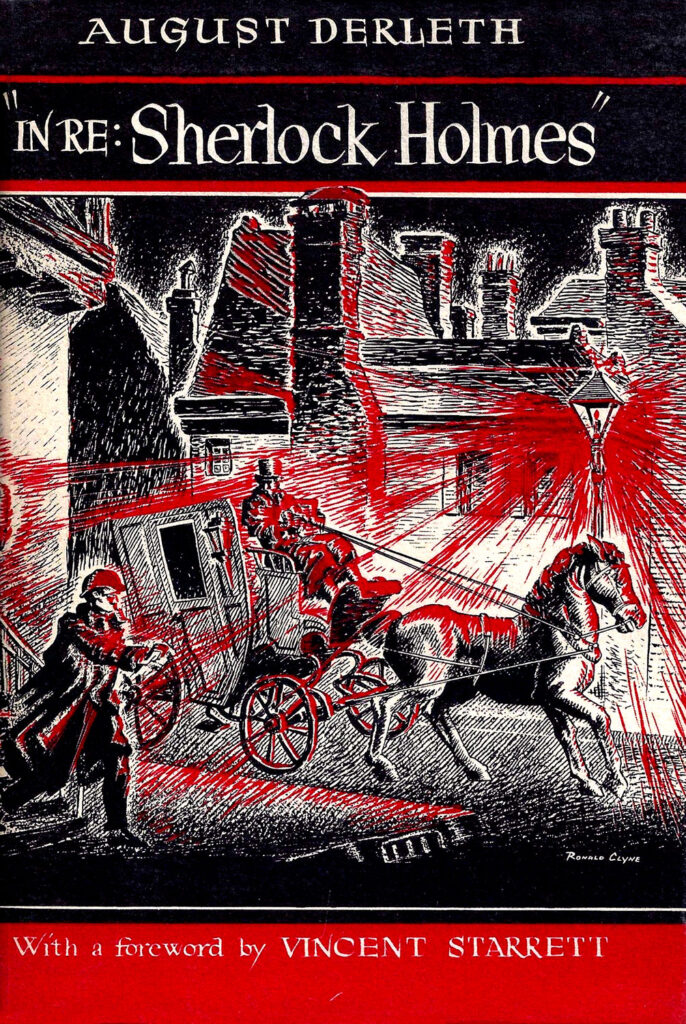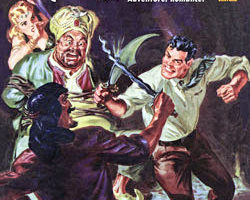 With this posting I start a re-reading (and in some cases first time reading) of the Solar Pons stories by both August Derleth and Basil Copper.
With this posting I start a re-reading (and in some cases first time reading) of the Solar Pons stories by both August Derleth and Basil Copper.
For those not up on things, Solar Pons is Derleth’s Sherlock Holmes pastiche, set in the 1920s and ’30s, which I’ve posted on previously. I realized that for most of these I hadn’t read them since I discovered Pons in college.
While I finally recently obtained the rest that I previously had no access to, I hadn’t yet read them. So I am reading through the eight-volume set of Solar Pons stories by August Derleth from Belanger Books, as well as the seven-volume set of stories by Basil Cooper from PS Publications. And I will be alternating between the two.
I will provide a synopsis of each story, but will not give away the ending. Any thing of particular interest, such as crossovers from other literary characters, I will note.
So we will start off with the first of the Solar Pons collections, In Re: Sherlock Holmes: The Adventures of Solar Pons (1945). In fact, it was with this book that Derleth started the Mycroft & Moran imprint of Arkham House.
Like many of the other Pons collections, this is a mix of reprints from magazines as well as new works. I had gotten the Pinnacle edition (which was titled Regarding Sherlock Holmes: The Adventures of Solar Pons), and as noted, I am reading the new Belanger edition. Four of the stories had originally appeared elsewhere, such as in Dragnet Magazine back in 1929, which makes Pons a pulp character. Three of the six pulp stories appear in this collection. While we don’t get the Pinnacle cover artwork reprinted in the Belanger editions, they do include the original Frank Utpatel covers from the Mycroft & Moran editions.
Folks may not realize that the first five Pons collections mirror the five Sherlock Holmes collections as they all use the same names — Adventures, Memories, Return, Reminescancs, and Casebook — and have about the same number of stories.
We kick things off with a pair of new intros. David Marcum gives a good overview of how Derleth created Pons, what lead to this collection, and what has happened with Pons as a character since then. A good portian of his intro will be repeated in all the other volumes. Derrick Belanger then follows with some of the firsts that happen in this colection.
Then moving into what was in the original editions, we get an introduction from Vincent Starrett (1886-1974). For those not aware, Starrett was a well-known bibliophile and member of the Baker Street Irregulars. And then comes “A Word From Dr. Lyndon Parker.” “A Word” gives Dr. Lyndon Parker‘s story of having met Pons after WWI and moving in with him.

As to the stories, we get the following:
In “The Adventure of the Frightened Baronet,” Pons and Parker are called in to help a veteran from the Indian service, who is concerned about a curse on a jewel called the “Eye of Shiva.” Others who were involved have died recently, and he has seen and heard things that makes him think he is next. But others in his family think he is perhaps losing his mind. Is there a curse, or is there another explanation?
“The Adventure of the Late Mr. Faversham” is one of the original pulp stories, and is actually based on an “unwritten” Sherlock Holmes stories — basically, a story hint given by Conan Doyle at the begining of a Holmes story. Mr. Faversham goes back into his house to get his umbrella, and is never seen again.
The first Pons story, “The Adventure of the Black Narcissus” has Pons looking into the murder of a crooked stock broker. The man accused of the crime shows up at Pons door, saying he’s innocent. Pons points out to Inspector Jamison that the presence of a black narcissus flower and other evidence should lead to someone else.
The first “new” Pons story, which started the revival, “The Adventure of the Norcross Riddle” has an American businessman approach Pons about strange goings on at his country estate. He had purchased it recently, and it had been the former home of his wife. Her first husband had died there in the fens on the estate. Now his wife is acting strangely and there appear to be tenants in the abandoned abbey on the property. What is going on?
In “The Adventure of the Retired Novelist,” a novelist comes to Pons with some strange events that caused him to be away from his house of short periods of time. It appears someone has been searching for something, but what? Pons thinks it’s tied to the previous owner and looks into it.
A murder has occured in “The Adventure of the Three Red Dwarfs.” One of two writer/artists living together has been killed. What is behind it? Is the other writer guilty, or was it someone else? And how do the “three red dwarfs” fit in?
Another murder is in “The Adventure of the Sotheby Salesman,” when the salesman in question is found shot in an empty house. Why was he there, and why was he murdered as it doesn’t appear he had any enemies?
With “The Adventure of the Purloined Periapt,” we have a story that many feel is the most Holmes-like. A young man had received a periapt, a jeweled amulet from his now deceased uncle. It has gone missing, and he can’t understand why. Pons is able to find it, and more importantly, figures out the importance of the periapt. Parker — and we — meet the Praed Street Irregulars, lead by Alfred Peake, for the first time.
Another of the original pulp stories, “The Adventure of the Limping Man,” has Pons and Parker take a much-needed vacation in the north of England. But Pons hopes to make it a “working vacation,” as he thinks one of his neighbors has an unsolved crime. At Melham Old House, one of two brothers disappeared on a trip to Prague three years prior. What happened to him? Now the daughter reaches out to Pons to help solve the issue of a strange limping man who appears to be lurking about. What is going on?
With “The Adventure of the Seven Passengers,” we are introduced to Baron Ennesfred Kroll, Pons’ Moriarty, so to speak. He is an arch-criminal and apparently a spy for Germany. During a naval conference, daily reports are being brought to the Minister of War. But for security, it has been broken into several parts and carried by several agents. But one day they find all the reports are missing. How did this occur? Can Pons retrieve the reports and, better yet, tie Kroll to this?
Baron Kroll returns in “The Adventure of the Lost Holiday.” Sadly, while he is mentioned in two other stories, he won’t appear elsewhere other than in an unfinished story. But keep in mind that Moriarty only appeared in two stories, though he is mentioned in six others. Here we have another case of political intrigue. England and France are working out secret plans to address Germany rearming (this I think sets the story in the 1930s), and these have gone missing. Can Pons get them back, and if Kroll is behind them, can he be tied in and be sent back to Germany?
A young lady comes to Pons with an issue in “The Adventure of the Man With a Broken Face.” Her father was a former sea captain, whose cargo ship was wrecked coming back from South Africa. He was the only survivor, and was able to return with one of two chests of diamonds. Now retired, he has been menaced by a man with a “broken face,” and has apparently gone missing. Can Pons find him, and what is the mystery behind this man?
So a great first collection. What I found interesting is that with several of the stories having Pons help the British government, that Bancroft Pons does not appear. But Derleth had not yet created this character. We’ll see if he appears in the next collection.
And I would love to see more with Baron Kroll, maybe with him as more an active participant. Maybe someone can use him in a future story. though I hope not too heavily used as Moriarty has become.
Look for the next Solar Pons review soon.




Great review. I’ve ordered the set from my independent bookstore
Very interesting review. Thanks.
[…] (Pulp Net): For those not up on things, Solar Pons is Derleth’s Sherlock Holmes pastiche, set in the 1920s […]